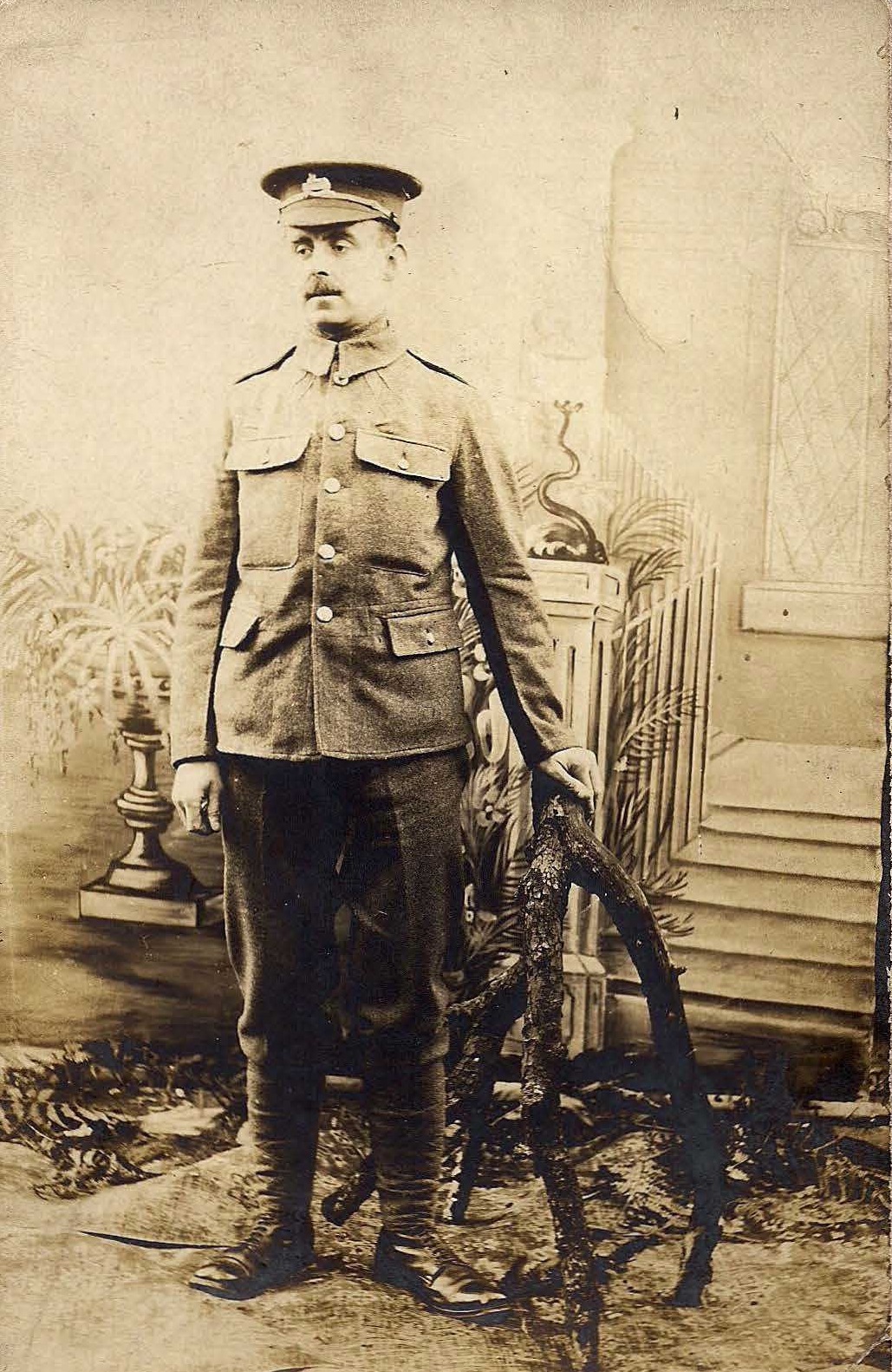L/Sjt
John Edward Walker
Informationen zu Geburt
|
Geburtsdatum: 04/07/1884 |
|
Geburtsort: Winthorpe, Nottinghamshire, England, Vereinigtes Königreich |
Allgemeine Informationen
|
Beruf: Valet |
Informationen zum Armeedienst
|
Land: England, Vereinigtes Königreich |
|
Truppe: British Expeditionary Force |
|
Rang: Lance Serjeant |
|
Dienstnummer: 15655 |
|
Einberufung datum: 05/03/1915 |
|
Einberufung ort: Newark-on-Trent, Nottinghamshire, England, Vereinigtes Königreich |
|
Einheiten: — Lincolnshire Regiment, 1st Bn. (Letzte bekannte Einheit) |
Informationen zu Tod
|
Sterbedatum: 04/10/1917 |
|
Sterbeort: Reutel, Beselare, Belgien |
|
Todesursache: Im Kampf gefallen |
|
Alter: 33 |
Gedenkstätte
|
Tyne Cot Memorial Tafel: 35 |
Auszeichnungen und Orden 3
|
1914-15 Star Medaille |
|
British War Medal Medaille — 19/07/1920 |
|
Victory Medal Medaille — 19/07/1920 |
Punkte von Interesse 3
| #1 | Geburtsort | ||
| #2 | Einberufung ort | ||
| #3 | Ort des Todes (ungefähr) |
Meine Geschichte
John Edward Walker was born in 1884 in Winthorpe, Nottinghamshire. He was the son of John Edward and Hannah Eliza Walker. According to the 1911 Census, John Edward was a valet at the Alton Manor in Idridgehay, Derbyshire. John enlisted in March 1915 and served with the 1st Battalion Lincolnshire Regiment, part of the 62nd Brigade, of the 21st Division. On the 4 October 1917, the 21st Division participated in the Battle of Broodseinde, a stage of the Battle of Passchendaele.
The 21st Division’s jumping off line was located near the eastern border of Polygon Wood. The attack on the hamlet of Reutel was planned as followed: the first objective was to be taken by the Queens (Royal West Surrey Regiment) 3rd/4th Battalion. Once the objective was captured, the 12th/13th Northumberland Fusiliers (on the right) and the 10th Bn. Yorkshire Regiment (on the left) were to advance to the second objective, the hamlet of Reutel. The 1st Bn. Lincolnshire Regiment would be in support. But things didn’t go as planned. While the 10th Bn. Yorkshire Regiment was on its way to the assembly point, it was caught in two heavy German barrages; one in Glencorse Wood and one at Black Watch Corner. The Battalion became disorganized, suffered heavy casualties and did not succeed in arriving on time at the assembly point. Therefore the 1st Lincolnshire took the place of the 10th Yorkshire in the line.
The attack started at 6 a.m. and the leading Battalions advanced behind a creeping barrage. The attacking Battalions had to overcome several obstacles; the first was the Polygonebeek. The banks of this small stream had been utterly destroyed by the constant shelling. Without proper irrigation the entire valley had been transformed in a marsh, making any quick advance through the muddy valley next to impossible. On top of the difficult terrain, the leading battalions were surprised by some well-hidden German concrete emplacements, on the east bank of the Polygonebeek. Nevertheless the 3rd/4th Queens succeeded in capturing these concrete shelters and at 7.45 a.m. they consolidated the first Objective. The 1st Lincolnshire and the 12th/13th Northumberland Fusiliers then continued the attack towards the Second Objective. Soon after the 1st Lincolnshire took over the advance they came under fire from Judge Copse. The heavy German machine-gun- and rifle fire caused considerable casualties. Yet the 1st Lincolnshire reached the hamlet the second and final objective at 11.30 a.m.
The thirty-three-year-old Lance Serjeant John Edward Walker fell during the attack on the hamlet of Reutel. John Edward Walker has no known grave and he is remembered on panel 35 of Tyne Cot Memorial.
The 21st Division’s jumping off line was located near the eastern border of Polygon Wood. The attack on the hamlet of Reutel was planned as followed: the first objective was to be taken by the Queens (Royal West Surrey Regiment) 3rd/4th Battalion. Once the objective was captured, the 12th/13th Northumberland Fusiliers (on the right) and the 10th Bn. Yorkshire Regiment (on the left) were to advance to the second objective, the hamlet of Reutel. The 1st Bn. Lincolnshire Regiment would be in support. But things didn’t go as planned. While the 10th Bn. Yorkshire Regiment was on its way to the assembly point, it was caught in two heavy German barrages; one in Glencorse Wood and one at Black Watch Corner. The Battalion became disorganized, suffered heavy casualties and did not succeed in arriving on time at the assembly point. Therefore the 1st Lincolnshire took the place of the 10th Yorkshire in the line.
The attack started at 6 a.m. and the leading Battalions advanced behind a creeping barrage. The attacking Battalions had to overcome several obstacles; the first was the Polygonebeek. The banks of this small stream had been utterly destroyed by the constant shelling. Without proper irrigation the entire valley had been transformed in a marsh, making any quick advance through the muddy valley next to impossible. On top of the difficult terrain, the leading battalions were surprised by some well-hidden German concrete emplacements, on the east bank of the Polygonebeek. Nevertheless the 3rd/4th Queens succeeded in capturing these concrete shelters and at 7.45 a.m. they consolidated the first Objective. The 1st Lincolnshire and the 12th/13th Northumberland Fusiliers then continued the attack towards the Second Objective. Soon after the 1st Lincolnshire took over the advance they came under fire from Judge Copse. The heavy German machine-gun- and rifle fire caused considerable casualties. Yet the 1st Lincolnshire reached the hamlet the second and final objective at 11.30 a.m.
The thirty-three-year-old Lance Serjeant John Edward Walker fell during the attack on the hamlet of Reutel. John Edward Walker has no known grave and he is remembered on panel 35 of Tyne Cot Memorial.
Quellen 5
|
"Passchendaele. The Day-by-Day Account", McCarthy C., London, Uniform, 2018, pg. 109-112. Verwendete Quellen |
|
Ancestry https://www.ancestry.com/ Weitere Quellen |
|
CWGC https://www.cwgc.org/find-war-dead/casualty/825713/walker,-john-edward/ Verwendete Quellen |
|
The Long, Long Trail http://www.longlongtrail.co.uk/army/ Verwendete Quellen |
|
War Diary Lincolnshire Regiment, 1st Bn. http://www.nmarchive.com/ Weitere Quellen |
